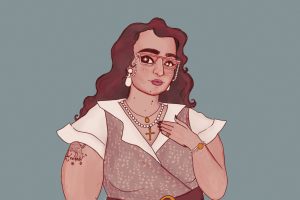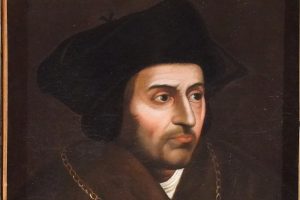What does it mean to be Black and Catholic? It means that I come to my church fully functioning; that doesn’t frighten you, does it? It means that… I bring myself, my Black self, all that I am, all that I have, all that I hope to become. It means I bring my whole history, my traditions, my experience, my culture, my African American song and dance and gesture and movement, and teaching and preaching and healing and responsibility as a gift to the church.
—Servant of God Sister Thea Bowman, F.S.P.A.
On a June day in Baltimore in 1989, Franciscan Sister Thea Bowman addressed the United States Conference of Catholic Bishops. Bowman was not only a trained English scholar and Catholic liturgist, but at this moment in history, she was also the first African American woman to address a meeting of U.S. Catholic hierarchies.
While the question “What does it mean to be Black and Catholic?” was initially intended to be a moral, ethical, and, in some ways, even a theological inquiry to the American episcopate, the question holds broader significance for the church and Black Catholics. This question was not only a challenge to the bishops to reflect upon their relationships with Black Catholics. It was an unequivocal statement to the predominantly white U.S. Catholic hierarchy that Black Catholics are a gift and a vital contribution to the Catholic Church. In declaring the African American experience as a “responsibility and gift to the church,” Bowman communicated to the American episcopate a much older understanding of the social and political contribution of the Black experience to American religion and religiosity.
W.E.B. Du Bois, a late 19th-century Harvard-trained African American intellectual and author of the earliest modern sociological treatments of African American religious life, often used the image of “the gift” in his writings. Sixty-five years before Bowman’s speech, Du Bois made a similar claim in his book The Gift of Black Folk (The Stratford Co.), written as a part of a series on race sponsored by the Knights of Columbus.
In this book, Du Bois highlights the “gifts” of Black Americans to the wider American society, focusing on the importance of Black religion in the final chapter. Highlighting Black religion as a significant contribution to the broader American social landscape, he recognized its connection to the historical narrative of Catholicism in the United States and the Americas.
“The history of Negro religion is bound up with the history of the Catholic Church,” Du Bois wrote, and that “black priests and an order of black monks in Spanish America” in the early 16th century are a part of the longer history of the Catholic Church in this supposedly New World.
While some might argue that Du Bois was simply pandering to a Catholic audience, such a statement would ignore the impact and significance of his declaration for Black Catholics. Indeed, Black Catholics have used and continue to use their intellectual talents and spiritual gifts for the betterment of the church.
Sister Mary Antona Ebo, F.S.M. born Elizabeth Louise Ebo on April 10, 1924, in Bloomington, Ill., was one of six nuns who joined the 1965 Selma to Montgomery voting rights march. When Martin Luther King, Jr., called on religious leaders to join the protest, Ebo joined with the St. Louis delegation. The Archdiocese had initially planned to send only priests, but this group, nicknamed the “Sisters of Selma,” made history as the first delegation of women religious to join the protest, standing prominently at the Edmund Pettus Bridge for the second march attempt after the events of Bloody Sunday.
On March 10, 1965, upon arriving at Brown Chapel African Methodist Episcopal Church, the protesters’ launch point, Ebo was introduced by future congressman Andrew Young Jr. as “one of the great moral forces of the world.” She would tell her fellow protesters: “I’m here because I’m a Negro, a nun, a Catholic, and because I want to bear witness.” Following her death on Nov. 11, 2017, her obituary from St. Louis Public Radio read, “From Selma to Ferguson, Sister Ebo bore witness for more than half a century.” Ebo, through the work of her ministry and public activism, demonstrates the power of Black Catholic prophetic witness to begin the work of healing and reconciliation.
Father Cyprian Davis, O.S.B. born Clarence John Davis on Sept. 9, 1930, in Washington, D.C., was a Benedictine priest and historian. A Catholic convert, he was the first African American to join St. Meinrad Archabbey in Indiana, becoming a novice on July 31, 1950, and taking the name Cyprian on Aug. 1, 1951. Ordained on May 3, 1956, he would go on to study church history at the Catholic University of Louvain in Belgium, receiving his doctorate in 1963. He taught church history at Saint Meinrad Seminary until 2012 and passed away in 2015. Davis authored the first comprehensive history of Catholics of African descent in the United States with his book The History of Black Catholics in the United States (Crossroad), changing how race issues are addressed in U.S. Catholic history. His contribution to the Black Catholic discourse includes his work in telling a more inclusive narrative of the church’s history.
Father Clarence Rufus Joseph Rivers, Jr. was born on Sept. 9, 1931, in Selma, Ala., and was a priest of the Archdiocese of Cincinnati and an early Black liturgist. He became the first African American ordained as a priest in the Archdiocese of Cincinnati on May 26, 1956. He earned his doctorate in African American culture and Catholic liturgy from the Union Institute in 1978. Alongside others such as Thea Bowman, Rivers spearheaded a movement to incorporate the African American musical tradition into Catholic worship. His hymn, “God is Love,” was debuted at the National Liturgical Conference in 1964 during the first Mass celebrated in English in the U.S. Catholic Church. His ministry aimed to affirm the significance of African American spirituality in the church through Black song and voice.
Rivers’ legacy, documented in the podcast “Meet Father Rivers” and his books The Spirit in Worship (Stimuli, Inc) and Soulfull Worship (Stimuli, Inc.), demonstrates that the definition of “Black and Catholic” is inseparable from the experience and practice of liturgy. He died on November 21, 2004, the Solemnity of Christ the King.
Father Joseph Brown, a Jesuit priest and scholar of the African diaspora, was born in East St. Louis, Ill. during the era of Jim Crow. He entered the Society of Jesus on Aug. 14, 1962, and was ordained on May 27, 1972. Thereafter, he would earn a doctorate in American Studies in 1984 from Yale. Brown has dedicated his ministry to advocating for a more expansive diasporic understanding of Black contributions to Catholicism in the United States, declaring that Black spiritualities are not at odds with Catholic religiosity.
His life’s journey, which included integrating an elementary school and his vivid recollection of his years of formation around the time of the assassination of the Rev. Dr. Martin Luther King Jr. in 1968 reminds us that the struggle for justice challenges the church to consider the question: Who defines the terms by which we live? Through his interdisciplinary approach to Black spirituality, Catholic theology, and identity, as demonstrated in his books, To Stand on the Rock: Meditations on Black Catholic Identity (Orbis), and A Retreat with Thea Bowman and Bede Abram: Leaning on the Lord (St. Anthony Messenger Press), prompts reflection on who has the power to shape our understanding of what it means to be Black and Catholic. Brown currently teaches and serves as the director of Africana and multicultural studies at Southern Illinois University Carbondale.
Mother Mary Wilhelmina of the Most Holy Rosary, born Mary Elizabeth Lancaster on April 13, 1924, was a sister renowned for her profound commitment to traditional monastic life and for founding the Benedictines of Mary, Queen of Apostles in Gower, Missouri. She entered religious life at the age of 17 as a member of the Oblate Sisters of Providence, a historically Black religious community for women. However, in 1995, at the age of 71, she left the Oblates and eventually found a contemplative order dedicated to the more traditional monastic life in 2006.
While some see her departure as illustrating theo-political divisions within the U.S. Catholic Church, her decision can be understood as an example of faithful discipleship, rooted in unwavering commitment to prayer and awareness of the will of God in her life. Wilhelmina was drawn into a hidden union with God, marked by a life of deep contemplation and monastic observance. Her steadfast adherence to tradition would define the rest of her life until she died in 2019 at age 95.
She drew international attention in 2023 when her body was exhumed and found to be incorrupt four years after her burial. The miraculous event sparked some to question whether she will be the first African American woman saint. At this moment, no case for canonization has been opened. The contribution of Wilhelmina to the discourse of the Black Catholic experience in the United States is a love of tradition and its power to unite across the divide of race.
As we remember the lives and teachings of Black Catholics during Black Catholic History Month, let us resist flattened narratives that overlook and belittle the unique gifts of Black life. As historians Stephen Ochs and Shannen Dee Williams have powerfully illustrated in their histories on Black priests and women religious, Black Catholics have not always had their gifts and vocations recognized and appreciated. In acknowledging this fact, along with the histories of the Black laity who have fought for racial justice within and outside the church, we continue the process of reconciliation, healing, and radical welcome. Is that not what the Thea Bowman would want us to do?
Through the gift of her writings and the legacy of her mentorship, Bowman taught Black Catholics how to see themselves as full and active participants in the life of the church. For much of the history of the church in the United States, Black people and communities were seen as sites of conversion. Yet, the Black Catholic spiritual and intellectual traditions prove the gross limitations of that narrative. Black Catholics have taught us, and continue to teach us, that Black histories, spiritualities, and worldviews help the church to understand what it means to be church in the modern era.
Image: Pexels/Cottonbro Studio















Add comment